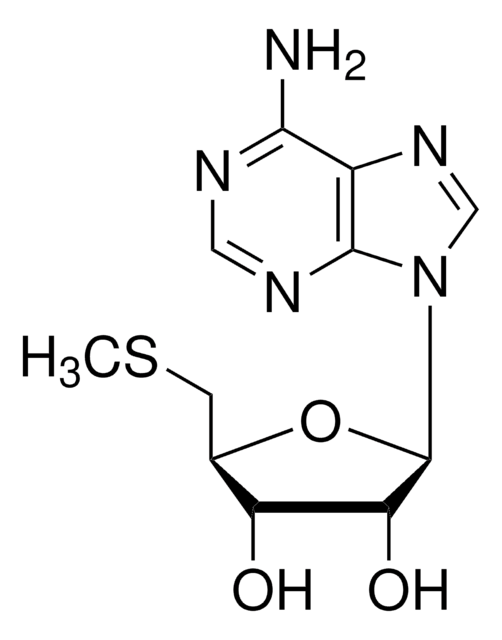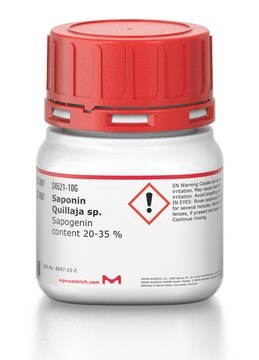About This Item
Recommended Products
biological source
plant seeds (Digitalis purpurea)
Quality Level
description
non-ionic
Assay
50% (TLC)
form
powder
mol wt
micellar avg mol wt 70,000
concentration
~50% (TLC)
aggregation number
60
CMC
<0.5 mM (20-25°C)
mp
230-240 °C (dec.) (lit.)
solubility
ethanol: 10 mg/mL, clear, colorless to faintly yellow
SMILES string
C[C@@]12[C@]([C@@H]3C)([H])[C@](O[C@]34CC[C@@H](C)CO4)([H])[C@@H](O)[C@@]1([H])[C@@](CC[C@]5([H])[C@@]6(C[C@@H](O)[C@H](O[C@]([C@@H]([C@@H](O)[C@H]7O[C@@](O[C@H](CO)[C@@H](O)[C@@H]8O[C@@](OC[C@@H](O)[C@@H]9O)([H])[C@@H]9O)([H])[C@@H]8O[C@@](O[C@H](CO)[C@H
InChI
1S/C56H92O29/c1-19-7-10-56(75-17-19)20(2)31-45(85-56)37(67)32-22-6-5-21-11-26(24(61)12-55(21,4)23(22)8-9-54(31,32)3)76-50-42(72)39(69)44(30(16-60)80-50)81-53-48(47(36(66)29(15-59)79-53)83-49-40(70)33(63)25(62)18-74-49)84-52-43(73)46(35(65)28(14-58)78-52)82-51-41(71)38(68)34(64)27(13-57)77-51/h19-53,57-73H,5-18H2,1-4H3/t19-,20+,21+,22-,23+,24-,25-,26-,27-,28-,29-,30-,31+,32-,33+,34-,35+,36-,37+,38+,39-,40-,41-,42-,43-,44+,45-,46+,47+,48-,49+,50-,51+,52+,53+,54-,55+,56-/m1/s1
InChI key
UVYVLBIGDKGWPX-KUAJCENISA-N
Looking for similar products? Visit Product Comparison Guide
General description
The detergent′s cellular permeabilization property extends to various cell types, enabling the study of intracellular components and processes by introducing antibodies, enzymes, or other molecules into cells. In immunocytochemistry experiments, Digitonin plays a crucial role by permeabilizing cells, allowing for the labeling and detection of intracellular proteins and structures, offering insights into cellular organization and protein localization. Furthermore, Digitonin facilitates RNA extraction and purification by lysing cells, a critical step for molecular biology applications such as gene expression analysis and RNA sequencing. The detergent′s utility is also evident in immunoprecipitation experiments, where it solubilizes membrane proteins, enabling the isolation of specific protein-antibody complexes for the study of protein interactions and signaling pathways.
Application
- to incubate isolated mitochondria for removing the mitochondrial outer membrane for mitoplasts preparation
- in the permeabilization of HeLa cells for in vitro import assay
- as a component in HEPES-buffered saline (HBS) to permeate the cells and release the aequorins for fluorescence and bioluminescence imaging
Biochem/physiol Actions
Features and Benefits
- Can extract membrane proteins like supercomplexes from the mitochondrial inner membrane
- Solubilizes 1-palmitoyl-2-oleoyl-sn-glycero-3-phosphocholine (POPC) large unilamellar vesicles (LUVs) gradually at high temperature
- Canorm micelles at a wide range of concentrations
Other Notes
comparable product
Signal Word
Danger
Hazard Statements
Precautionary Statements
Hazard Classifications
Acute Tox. 3 Oral - STOT RE 2
Storage Class Code
6.1C - Combustible acute toxic Cat.3 / toxic compounds or compounds which causing chronic effects
WGK
WGK 3
Flash Point(F)
Not applicable
Flash Point(C)
Not applicable
Personal Protective Equipment
Choose from one of the most recent versions:
Already Own This Product?
Find documentation for the products that you have recently purchased in the Document Library.
Customers Also Viewed
Our team of scientists has experience in all areas of research including Life Science, Material Science, Chemical Synthesis, Chromatography, Analytical and many others.
Contact Technical Service











